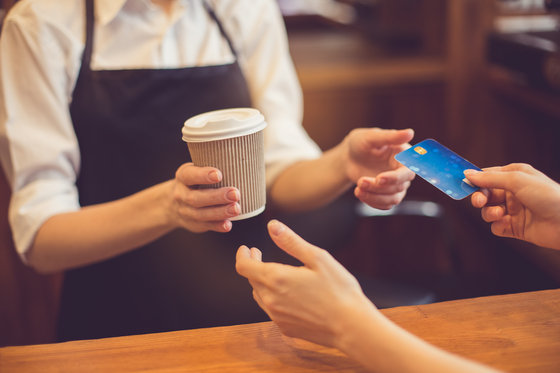
Shutterstock
It was found that non-face-to-face consumption increased significantly due to the spread of the novel coronavirus infection (Corona 19). This is because going out has decreased due to reinforced social distancing, and the tendency to pay online instead of using a physical card has increased. As a result of this, it is estimated that the size of credit card use declined for the first time in 16 years.
According to the’Domestic Payment and Settlement Trends in 2020′ released by the Bank of Korea on the 16th, the average daily use of payment cards (credit, debit cards, etc.) last year was estimated at 2.52 trillion won, an increase of 0.6% from the previous year. As consumption activity contracted due to the spread of Corona 19, the increase compared to the previous year fell significantly from 2019 (5.8%).
Among them, the average daily use of credit cards was totaled at 1.96 trillion won, down 0.3% from the previous year. In the past, credit card usage decreased only three times in 1998 (-9.1%) at the time of the financial crisis, 2003 (-22.2%) and 2004 (-26.8%) when the credit card crisis occurred. It is the first time in 16 years that the scale of credit card use has decreased due to the spread of Corona 19.
The average daily use of check cards was 540 billion won, up 1.5% from the previous year. Although it increased slightly, the increase was significantly lower than in 2017 (7.7%), 2018 (5.9%), and 2019 (6.2%). On the other hand, the average daily use of prepaid cards reached 17 billion won, an increase of 590.8% from the previous year due to emergency disaster support funds from the government and local governments.

Source: Bank of Korea, full-time credit card company and card business combined bank, financial investment company, KFTC, etc.
Last year, there were two major times when the use of payment cards decreased significantly from a year ago. The first decrease was seen in March (-7.4%) and April (-4.4%) of last year when the spread of Corona 19 began in earnest. Face-to-face consumption is greatly reduced due to the government’s policy to strengthen social distancing. After that, it showed a slight increase in May (0.9%), but decreased significantly again in December (-5.4%) with the re-proliferation of Corona 19.
With the spread of Corona 19, non-face-to-face payments using mobile devices such as PCs and smartphones have increased significantly. Last year, the average daily non-face-to-face payment was estimated at 849 billion won, an increase of 16.9% from the previous year. On the other hand, the average daily face-to-face payment was found to be 1.398 trillion won, down 5.6% from the previous year.
Non-face-to-face payments have steadily increased even before the spread of Corona 19. It increased by 7.4 percentage points from 32.2% in the first quarter of 2019 to 39.6% in the fourth quarter of last year. This is due to the increased number of payment methods, such as Samsung Pay or Kakao Pay, installed on mobile devices, instead of using a physical card, even when making in-person payments.
When using mobile devices, the proportion of using simple payment services (services that store card information on mobile and use simple authentication methods such as password and fingerprint recognition) also showed an increasing trend. The proportion of mobile simple payment services in the first quarter of 2019 accounted for 34.2%, but increased to 41.5% in the fourth quarter of last year, increasing by 7.3 percentage points.

Source: Bank of Korea
When using simple payment services, the proportion of finding services from fintech companies instead of card companies is still increasing. In the fourth quarter of last year, the proportion of using fintech’s simple payment service was 61.7%, which was significantly ahead of the card company’s simple payment service utilization rate (38.7%). The proportion of using fintech payment services has been steadily increasing from the first quarter of 2019 (53.4%), when statistics began to be collected.
As a result of analyzing the classification by credit card consumption type last year, the use of e-commerce (24.2%), automobile (20.6%), and furniture/home appliances (6.3%) sectors increased, but most sectors except this showed a decline. In particular, the scale of use of travel (-66%), education (-17.1%), and restaurants (-14.3%) was hit directly by the spread of Corona 19.
The size of credit card use by region decreased significantly compared to the previous year in all regions except the metropolitan area (5.4%). In the metropolitan area, there are many large e-commerce companies such as online shopping malls, so the scale of use increased, but in the rest of the regions, consumption declined due to the spread of Corona 19, and the scale of use decreased.
Reporter Yoon Sang-eon [email protected]
![]()
